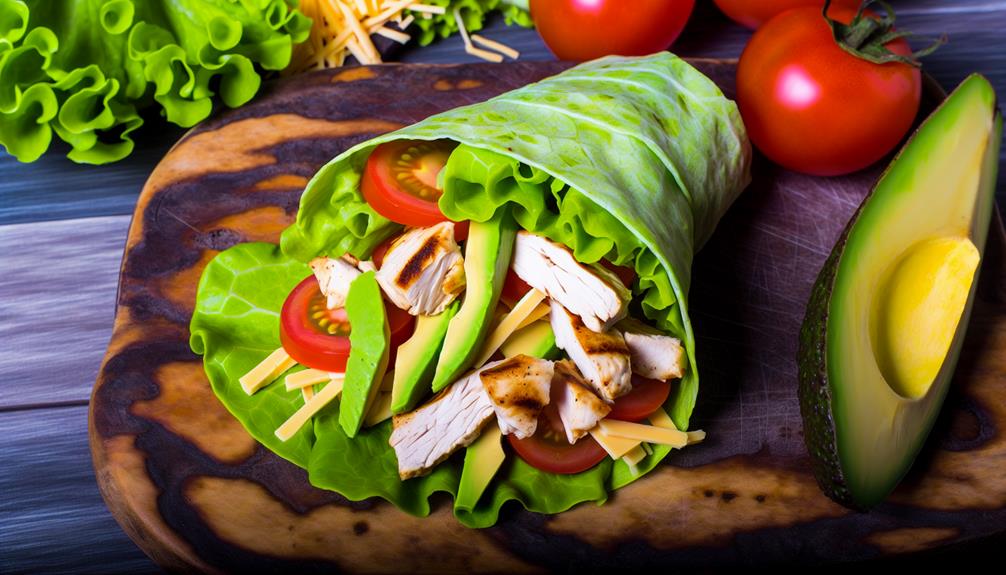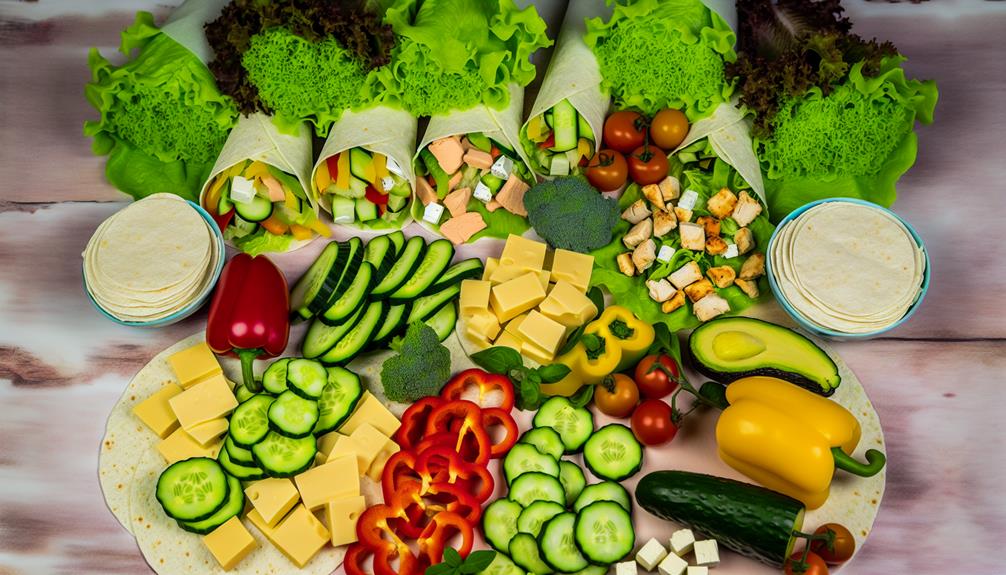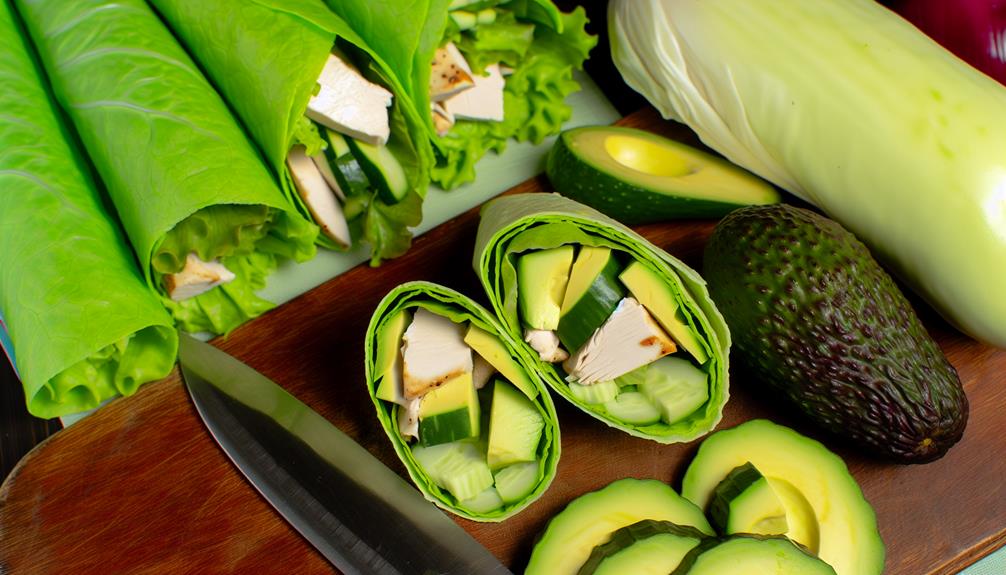Low-carb wraps offer a nutrient-dense alternative to traditional high-carb options. You'll need almond flour, coconut flour, eggs, psyllium husk powder, and seasonings. Mix ingredients, knead the dough, and cook on a non-stick pan. These wraps are packed with protein and fiber, helping maintain stable blood sugar levels and promoting satiety. They're versatile for various fillings like grilled chicken with avocado or scrambled eggs with veggies. You can store them in the fridge for 3-4 days and reheat as needed. With lower calories and carbs than regular wraps, they support weight management and overall health. Discover how these wraps can revolutionize your meals and snacks.
Key Takeaways
- Mix almond flour, eggs, psyllium husk, and seasonings to create a pliable dough for low-carb wraps.
- Cook the wraps on a non-stick pan or griddle until golden and flexible.
- Experiment with ingredient substitutions like coconut flour or flaxseed meal for different flavors and textures.
- Fill wraps with protein-rich options like grilled chicken, avocado, and vegetables for a balanced meal.
- Store wraps in an airtight container in the fridge for 3-4 days, reheating as needed.
Benefits of Low Carb Wraps

Low-carb wraps offer a nutrient-dense alternative to traditional high-carb options, helping you maintain stable blood sugar levels while providing essential fiber and protein. By choosing these wraps, you're taking a positive step towards better health and potentially supporting weight loss efforts. The reduced carbohydrate content helps prevent blood sugar spikes, which can lead to energy crashes and increased hunger.
You'll likely notice improved energy levels throughout the day when incorporating low-carb wraps into your diet. The stable blood sugar levels contribute to sustained energy, allowing you to stay focused and productive. Additionally, these wraps often contain more fiber than their high-carb counterparts, promoting better digestion and gut health.
For those serving others, particularly individuals with diabetes or those trying to manage their weight, offering low-carb wraps can be a thoughtful and health-conscious choice. You're providing a satisfying meal option that doesn't compromise on taste or nutrition.
Ingredients You'll Need
To create these nutritious wraps, you'll need a handful of key ingredients that are both low in carbohydrates and rich in essential nutrients. Start with low carb flour alternatives such as almond flour, coconut flour, or ground flaxseed. These options provide a good base for your wraps while keeping the carb count low and offering beneficial fats and fiber.
You'll also need eggs, which act as a binding agent and contribute protein to the recipe. Olive oil or coconut oil can be used to add moisture and healthy fats. For texture and additional nutrients, consider incorporating psyllium husk powder, which is high in fiber and helps create a pliable wrap.
Don't forget about flavorful seasonings to enhance the taste of your wraps. Options like garlic powder, onion powder, dried herbs, or even a pinch of salt can make a significant difference. These seasonings not only improve flavor but also offer various health benefits, such as antioxidant properties and potential anti-inflammatory effects.
Step-by-Step Preparation Guide

To create your low-carb wraps, you'll start by gathering all the necessary ingredients.
Next, you'll mix and knead the dough, ensuring it reaches the right consistency for optimal texture and nutritional value.
Gather Ingredients
Before diving into the preparation, you'll need to gather a few key ingredients that form the foundation of these nutrient-dense, low-carb wraps. Here's a list of essential items you'll need:
| Main Ingredients | Optional Add-ins |
|---|---|
| Almond flour | Herbs (rosemary, thyme) |
| Coconut flour | Spices (garlic powder, cumin) |
| Psyllium husk | Grated cheese |
| Eggs | Seeds (chia, flax) |
These ingredients provide a versatile base for your wraps, allowing for various ingredient substitutions and flavor combinations. For instance, you can swap almond flour for sunflower seed flour if you're dealing with nut allergies. Experiment with different herbs and spices to create unique taste profiles that complement your fillings.
When it comes to cooking techniques, you'll be using a non-stick pan or griddle to ensure easy flipping and even cooking. As for meal prep tips, consider making a larger batch and storing them in the refrigerator for quick, healthy meals throughout the week. By having these low-carb wraps on hand, you're not only serving your own health needs but also providing nutritious options for your family or guests.
Mix and Knead Dough
Now that you've gathered your ingredients, it's time to mix and knead the dough for your nutrient-dense, low-carb wraps. Begin by combining the dry ingredients in a large bowl, ensuring they're well-mixed. Create a well in the center and add the wet ingredients. Using a fork or your hands, gradually incorporate the dry mixture into the wet until a shaggy dough forms.
To achieve the perfect dough consistency, follow these kneading techniques:
- Turn the dough onto a clean, lightly floured surface.
- Use the heel of your hand to push the dough away from you, then fold it back over itself.
- Rotate the dough a quarter turn and repeat the process.
- Continue kneading for 5-7 minutes until the dough becomes smooth and elastic.
As you knead, you'll notice the dough becoming more cohesive and less sticky. This process helps develop the gluten-free proteins in your alternative flours, creating a pliable texture ideal for wraps.
Remember, proper kneading is crucial for achieving the right consistency, ensuring your low-carb wraps hold together well and provide a satisfying texture.
Once your dough reaches the desired consistency, it's ready for the next step in your health-conscious culinary journey.
Cook and Serve Wraps
With your perfectly kneaded dough ready, you'll follow these step-by-step instructions to cook and serve your nutritious, low-carb wraps. First, divide the dough into equal portions and roll each into thin circles.
Heat a non-stick skillet over medium heat. Cook each wrap for about 30 seconds per side, or until light brown spots appear. As you cook, stack the wraps between clean kitchen towels to keep them warm and pliable.
Now it's time to explore wrap alternatives and flavorful fillings. These low-carb wraps are versatile and can replace traditional high-carb options in various dishes. Fill them with lean proteins like grilled chicken or turkey, along with an array of colorful vegetables for added nutrients and fiber.
For a Mediterranean twist, try hummus, feta, and cucumber. If you're serving a crowd with diverse dietary needs, set up a wrap bar with various fillings, allowing guests to customize their meals.
Nutritional Information
You'll find these low carb wraps offer a significant nutritional advantage over traditional options. They boast a favorable macronutrient breakdown, with reduced carbohydrates and increased protein content.
Comparing calorie counts, you'll notice these wraps are often lower in overall calories while providing higher fiber, making them a nutrient-dense choice for health-conscious individuals.
Macronutrient Breakdown
These low carb wraps offer a balanced macronutrient profile that's ideal for those following a ketogenic or low carb diet. When you're trying to maintain a healthy lifestyle while reducing carbohydrate intake, it's crucial to understand the nutritional value of your food choices. These wraps provide a satisfying alternative to traditional high-carb options, allowing you to enjoy your favorite meals without compromising your dietary goals.
Here's a breakdown of the macronutrients in each wrap:
- Protein: 6-8 grams, supporting muscle maintenance and repair
- Healthy fats: 10-12 grams, providing sustained energy and promoting satiety
- Net carbs: 3-5 grams, significantly lower than traditional wraps
- Fiber: 8-10 grams, aiding digestion and promoting feelings of fullness
Calorie Count Comparison
Building on the macronutrient profile, let's examine how these low carb wraps stack up against traditional options in terms of overall calorie content. When you're following low carb diets, it's crucial to understand the calorie differences between various wraps alternatives. Here's a comparison of our low carb wraps recipe with common store-bought options:
| Wrap Type | Calories | Carbs (g) | Protein (g) |
|---|---|---|---|
| Low Carb Recipe | 120 | 4 | 15 |
| Flour Tortilla | 210 | 35 | 6 |
| Whole Wheat Wrap | 180 | 30 | 8 |
| Lettuce Wrap | 5 | 1 | 0.5 |
| Corn Tortilla | 140 | 25 | 3 |
As you can see, our low carb wraps offer a significant calorie reduction compared to traditional flour and whole wheat options. They're slightly higher in calories than a lettuce wrap, but provide substantially more protein and a more satisfying texture. By choosing these low carb wraps, you'll be able to enjoy your favorite wrap-based meals while maintaining a calorie-conscious approach to your diet. This makes them an excellent choice for those serving health-focused individuals or those looking to manage their weight effectively.
Fiber and Protein Content
One of the key nutritional advantages of these low carb wraps is their impressive fiber and protein content, which can significantly contribute to your daily intake of these essential nutrients.
The fiber benefits include improved digestion, better blood sugar control, and increased feelings of fullness.
Protein sources in these wraps typically come from ingredients like almond flour, eggs, or added protein powders, providing muscle fuel and aiding in tissue repair.
To fully appreciate the nutritional value of these wraps, consider the following:
- Fiber acts as a digestion aid, promoting regular bowel movements and supporting gut health.
- Protein helps maintain and build muscle mass, making these wraps an excellent option for those with active lifestyles.
- The combination of fiber and protein can help you feel satisfied for longer, potentially reducing overall calorie intake.
- These nutrients work together to stabilize blood sugar levels, which is particularly beneficial for those managing diabetes or watching their carbohydrate intake.
Filling Ideas

Versatile low-carb wraps can accommodate a wide range of nutritious fillings, allowing you to create balanced meals that suit your dietary needs and taste preferences. When considering filling combinations, focus on incorporating lean proteins, healthy fats, and fiber-rich vegetables to maintain the wrap's low-carb integrity while maximizing nutritional value.
Try pairing grilled chicken with avocado and spinach for a protein-packed, heart-healthy option. For a Mediterranean-inspired wrap, combine hummus, feta cheese, cucumber, and tomatoes.
If you're looking for a breakfast option, scrambled eggs with bell peppers and onions make an excellent filling choice. These flavor pairings not only enhance taste but also provide a variety of essential nutrients.
For those serving others with specific dietary requirements, consider allergen-free options like tuna salad with celery and lettuce or roasted vegetables with a tahini spread. You can also experiment with different herbs and spices to add flavor without increasing carb content.
Storing and Reheating
To maintain the quality of your low-carb wraps, proper storage is crucial. You'll want to keep them in an airtight container in the refrigerator for up to 3-4 days, ensuring they stay fresh and retain their nutritional value.
When it's time to enjoy your wraps again, you can reheat them in a pan or microwave, but be careful not to overheat, as this can compromise their texture and nutrient content.
Proper Storage Techniques
Proper storage of your low-carb wraps is crucial for maintaining their freshness, texture, and nutritional value. To ensure your wraps stay delicious and ready to serve, follow these proper wrapping techniques and optimal storage conditions:
- Allow wraps to cool completely before storing to prevent condensation and sogginess.
- Wrap each individual wrap tightly in plastic wrap or aluminum foil to create an airtight seal.
- Place wrapped wraps in an airtight container or resealable plastic bag for added protection.
- Store in the refrigerator for up to 3-4 days, or freeze for up to 2 months.
Best Reheating Methods
Reheating your low-carb wraps correctly preserves their texture and nutritional value, ensuring you'll enjoy a delicious and healthy meal every time. To maintain optimal flavor and nutrient retention, consider these reheating tips.
For a crispy exterior, use a dry skillet over medium heat for 1-2 minutes per side. This method preserves the wrap's structure while enhancing its taste. Alternatively, a toaster oven set at 350°F for 3-5 minutes can yield similar results.
If you're short on time, microwave reheating is an option. Place the wrap on a microwave-safe plate, cover with a damp paper towel, and heat for 30-45 seconds. This method helps retain moisture and prevents the wrap from drying out.
For those who meal prep, consider storing your wraps with flavor options like fresh herbs or spices to infuse additional taste during reheating. Storage hacks include separating layers with parchment paper to prevent sticking and using airtight containers to maintain freshness.
Variations and Substitutions

While this low-carb wrap recipe is versatile, you can easily customize it to suit your dietary needs and taste preferences. Consider these variations and substitutions to create a wrap that's perfect for you or those you're serving:
- Flour alternatives: Replace almond flour with coconut flour for a nut-free option, or use a blend of flaxseed meal and psyllium husk for added fiber.
- Protein boost: Incorporate unflavored protein powder or collagen peptides to increase the protein content and improve texture.
- Herbal infusions: Add dried herbs like basil, oregano, or rosemary to the dough for a flavor-packed wrap that complements various fillings.
- Vegetable integration: Mix in finely grated zucchini, spinach, or carrots for extra nutrients and a colorful appearance.
These wraps variations offer endless possibilities for flavor combinations and texture options. You can create savory wraps by adding garlic powder and Parmesan cheese, or sweeten them with cinnamon and stevia for a dessert-like treat.
Experiment with different thicknesses to achieve your desired pliability. Remember, these substitutions may affect the carb count slightly, so adjust accordingly if you're strictly monitoring your carbohydrate intake.
Serving Suggestions
With these versatile low-carb wraps in hand, you've got a world of healthy, delicious meal options at your fingertips. Let's explore some creative fillings and wrap pairings that'll satisfy your taste buds while keeping your carb intake in check.
Here's a table showcasing some nutrient-rich combinations:
| Protein | Veggies | Healthy Fat |
|---|---|---|
| Grilled chicken | Spinach & tomatoes | Avocado slices |
| Smoked salmon | Cucumber & dill | Cream cheese |
| Roasted turkey | Bell peppers & lettuce | Olive tapenade |
| Scrambled eggs | Mushrooms & onions | Feta cheese |
For a breakfast option, try filling your wrap with scrambled eggs, sautéed veggies, and a sprinkle of low-fat cheese. If you're looking for a lunch idea, consider a Mediterranean-inspired wrap with grilled chicken, cucumbers, tomatoes, and a dollop of tzatziki sauce.
Don't forget about vegetarian options! You can create a delicious and filling wrap using hummus, roasted vegetables, and a handful of mixed greens. For those with a sweet tooth, spread some almond butter on your wrap and add sliced strawberries for a nutritious snack or dessert alternative.
Tips for Perfect Wraps

Mastering the art of perfect low-carb wraps requires attention to a few key details that'll enhance both their taste and texture. To achieve optimal results, consider these essential tips:
- Wrapping techniques: Roll your wraps tightly to prevent ingredients from falling out. Fold the bottom up slightly before rolling from one side to create a secure pocket.
- Flavor combinations: Experiment with various low-carb fillings to keep your wraps exciting. Try combining lean proteins with nutrient-dense vegetables and healthy fats for a well-balanced meal.
- Cooking hacks: If using lettuce wraps, briefly soak the leaves in ice water to crisp them up. For coconut flour wraps, let the batter rest for a few minutes before cooking to allow the flour to absorb the liquid.
- Presentation ideas: Cut your wraps diagonally for an attractive display, or slice them into pinwheels for bite-sized appetizers.
Remember to avoid overfilling your wraps, as this can lead to tearing and messy eating. By focusing on these tips, you'll create delicious, visually appealing low-carb wraps that'll impress your family and friends while supporting their health goals.
Health Considerations
Beyond mastering the perfect wrap technique, it's important to understand the health implications of your low-carb wrap choices. These wraps can be an excellent option for those with dietary restrictions or specific taste preferences, offering a versatile alternative to traditional high-carb breads.
When selecting ingredients for your low-carb wraps, consider potential allergies. Many recipes use almond flour or coconut flour, which may not be suitable for those with nut allergies. Always offer alternatives or clearly label ingredients to ensure safety for those you're serving.
Portion control is crucial when incorporating low-carb wraps into your diet. While they're lower in carbohydrates, they can still contribute to calorie intake. Be mindful of serving sizes and balance your wrap fillings with nutrient-dense options like lean proteins and vegetables.
Low-carb wraps can be beneficial for blood sugar management and weight control. They're often high in fiber and protein, which can help you feel fuller for longer. However, it's essential to consider the overall nutritional profile of your meal. Ensure you're getting a balance of macronutrients and micronutrients to support your health goals while enjoying these tasty alternatives.
Conclusion
You've now got the tools to create delicious, low-carb wraps that'll support your health goals. Remember, replacing high-carb tortillas with these alternatives can significantly reduce your carbohydrate intake.
In fact, a standard flour tortilla contains about 36g of carbs, while these low-carb wraps typically have less than 5g. By making this simple switch, you're not only cutting calories but also improving your blood sugar control and potentially aiding weight management.
Enjoy experimenting with different fillings and variations!
Leave a Reply